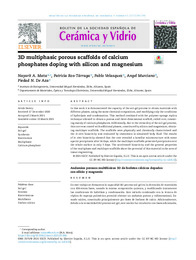Please use this identifier to cite or link to this item:
https://hdl.handle.net/11000/35848Full metadata record
| DC Field | Value | Language |
|---|---|---|
| dc.contributor.author | Mata, Nayarit A. | - |
| dc.contributor.author | Ros-Tárraga, Patricia | - |
| dc.contributor.author | Velasquez, Pablo | - |
| dc.contributor.author | Murciano, Angel | - |
| dc.contributor.author | De Aza, Piedad | - |
| dc.contributor.other | Departamentos de la UMH::Ciencia de Materiales, Óptica y Tecnología Electrónica | es_ES |
| dc.date.accessioned | 2025-03-07T09:43:58Z | - |
| dc.date.available | 2025-03-07T09:43:58Z | - |
| dc.date.created | 2022 | - |
| dc.identifier.citation | Bo l e t í n d e l a s o c i e d a d e s p a ñ o l a d e c e r á m i c a y v i d r i o 6 1 (2 0 2 2) 384–396 | es_ES |
| dc.identifier.issn | 2173-0431 | - |
| dc.identifier.uri | https://hdl.handle.net/11000/35848 | - |
| dc.description.abstract | In this work it is demonstrated the capacity of the sol–gel process to obtain materials with different phases, using the same chemical composition, and modifying only the conditions of hydrolysis and condensation. This method combined with the polymer sponge replica technique allowed to obtain a porous and three-dimensional scaffold, called core, consisting mainly of calcium phosphates. Additionally, due to the versatility of the sol–gel process, this core was coated with additional phases, constituted by silicon and magnesium, obtaining multilayer scaffolds. The scaffolds were physically and chemically characterized and the in vitro bioactivity was evaluated by immersion in simulated body fluid. The results of in vitro bioactivity showed that the core revealed a lamellar microstructure with some apatite precipitates after 14 days, while the multilayer scaffolds presented precipitates over the whole surface in only 3 days. The accelerated bioactivity and the general properties of the multiphase and multilayer scaffolds show the potential of this material in the area of tissue engineering. | es_ES |
| dc.description.abstract | En este trabajo se demuestra la capacidad del proceso sol-gel en la obtención de materiales con diferentes fases, usando la misma composición química, y modificando únicamente las condiciones de hidrólisis y condensación. Este método combinado con la técnica de réplica de esponja polimérica permitió obtener un andamio poroso y tridimensional, llamado núcleo, constituido principalmente por fases de fosfatos de calcio. Adicionalmente, debido a la versatilidad del proceso sol-gel, este núcleo fue recubierto con fases adicionales, constituidas por silicio y magnesio, obteniendo andamios multicapa. Los andamios fueron caracterizados física y químicamente y la bioactividad in vitro evaluada mediante inmersión en suero fisiológico artificial. Los resultados de bioactividad in vitro mostraron que el núcleo reveló una microestructura lamelar con algunos precipitados de apatito después de 14 días, mientras que los andamios multicapa presentaron precipitados sobre la superficie en solo 3 días. La bioactividad acelerada y las propiedades generales del andamio multifásico y multicapa, demuestran el potencial de este material en el área de ingeniería de tejido | es_ES |
| dc.format | application/pdf | es_ES |
| dc.format.extent | 13 | es_ES |
| dc.language.iso | eng | es_ES |
| dc.publisher | Elsevier | es_ES |
| dc.rights | info:eu-repo/semantics/openAccess | es_ES |
| dc.rights | Attribution-NonCommercial-NoDerivatives 4.0 Internacional | * |
| dc.rights.uri | http://creativecommons.org/licenses/by-nc-nd/4.0/ | * |
| dc.subject | Sol–gel | es_ES |
| dc.subject | Synthesis | es_ES |
| dc.subject | Bioceramics | es_ES |
| dc.subject | Multiphasic | es_ES |
| dc.subject | Calcium phosphate | es_ES |
| dc.subject.other | CDU::6 - Ciencias aplicadas | es_ES |
| dc.title | 3D multiphasic porous scaffolds of calcium phosphates doping with silicon and magnesium | es_ES |
| dc.type | info:eu-repo/semantics/article | es_ES |

View/Open:
1-s2.0-S0366317521000194-main.pdf
6,25 MB
Adobe PDF
Share:
.png)
